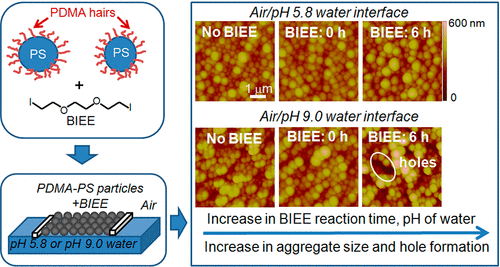Our official English website, www.x-mol.net, welcomes your feedback! (Note: you will need to create a separate account there.)
Effect of the Addition of a Cross-Linker and the Water pH on the Physical Properties of Films of pH-Responsive Polymer Particles at Air/Water Interfaces
ACS Omega ( IF 4.1 ) Pub Date : 2017-11-13 00:00:00 , DOI: 10.1021/acsomega.7b01241 Yuka Azakami 1 , Michael Kappl 2 , Syuji Fujii 3 , Shin-ichi Yusa 4 , Cathy E. McNamee 1
ACS Omega ( IF 4.1 ) Pub Date : 2017-11-13 00:00:00 , DOI: 10.1021/acsomega.7b01241 Yuka Azakami 1 , Michael Kappl 2 , Syuji Fujii 3 , Shin-ichi Yusa 4 , Cathy E. McNamee 1
Affiliation

|
We investigated how the stiffness and physical properties of films of pH-responsive polystyrene nanoparticles with poly(2-(N,N-dimethylamino)ethylmethacrylate) hairs (PDMA–PS particles) at air/water interfaces could be varied by using the cross-linker of 1,2-bis-(2-iodoethoxy)ethane (BIEE) and by varying the water pH. The physical properties of the film were investigated by using a Langmuir trough, atomic force microscope, and monolayer particle interaction apparatus. Films without large (μm-sized) holes were prepared by reacting BIEE with the PDMA–PS particles in the ethanol spreading solution for times ≤6 h and then by spreading this solution on a pH 5.8 water surface. Longer reaction times or a pH 9.0 water surface gave films with large holes. The holes were the result of the presence of aggregates of various sizes, which could not efficiently pack in the film. The aggregates were formed by interparticle adhesions because of the BIEE presence and physical attractive forces. The pH 5.8 water gave less aggregation than the pH 9.0 water because of the stronger interparticle electrostatic repulsions that resulted from the higher particle charge in pH 5.8 water than pH 9.0 water. The holes in the films could be decreased by reacting BIEE with the PDMA–PS particles on the pH 5.8 or 9.0 water surface, while the film was compressed to give a close packing density. The stiffness of the film of PDMA–PS particles increased, when BIEE was reacted with the PDMA–PS particles in the spreading solution for 1 h and was then spread on a pH 5.8 water surface. The film stiffness, however, did not increase, when BIEE was reacted with PDMA–PS particles on the pH 5.8 or 9.0 water surface for 1 h. This stiffness difference was explained by the fact that the former method gave a thicker film than the latter method.
中文翻译:

添加交联剂和水的pH值对空气/水界面的pH响应型聚合物颗粒薄膜的物理性能的影响
我们研究了具有pH响应的聚(2-(N,N通过使用1,2-双-(2-碘乙氧基)乙烷(BIEE)的交联剂和改变水的pH值,可以改变空气/水界面处的-二甲氨基)乙基甲基丙烯酸酯)毛发(PDMA-PS颗粒)。通过使用Langmuir槽,原子力显微镜和单层颗粒相互作用设备研究了薄膜的物理性能。通过将BIEE与PDMA-PS颗粒在乙醇铺展溶液中反应≤6h,然后将该溶液铺展在pH 5.8的水表面上,可以制备没有大孔(μm尺寸)的薄膜。较长的反应时间或pH值为9.0的水表面会产生带有大孔的薄膜。这些孔是存在各种尺寸的聚集体的结果,这些聚集体不能有效地包装在薄膜中。由于BIEE的存在和物理吸引力,颗粒之间的粘附形成了聚集体。pH 5.8的水比pH 9.0的水聚集少,这是因为pH 5.8的水比pH 9.0的水具有更高的粒子电荷,从而产生了更强的粒子间静电斥力。通过使BIEE与pH 5.8或9.0的水表面上的PDMA-PS颗粒反应,可以减少膜中的孔,同时将膜压缩以提供紧密的堆积密度。当BIEE与铺展溶液中的PDMA–PS颗粒反应1 h,然后在pH 5.8的水表面铺展时,PDMA–PS颗粒膜的刚度增加。但是,当BIEE与pH 5.8或9.0的水表面上的PDMA-PS颗粒反应1小时时,膜的硬度没有增加。
更新日期:2017-11-13
中文翻译:

添加交联剂和水的pH值对空气/水界面的pH响应型聚合物颗粒薄膜的物理性能的影响
我们研究了具有pH响应的聚(2-(N,N通过使用1,2-双-(2-碘乙氧基)乙烷(BIEE)的交联剂和改变水的pH值,可以改变空气/水界面处的-二甲氨基)乙基甲基丙烯酸酯)毛发(PDMA-PS颗粒)。通过使用Langmuir槽,原子力显微镜和单层颗粒相互作用设备研究了薄膜的物理性能。通过将BIEE与PDMA-PS颗粒在乙醇铺展溶液中反应≤6h,然后将该溶液铺展在pH 5.8的水表面上,可以制备没有大孔(μm尺寸)的薄膜。较长的反应时间或pH值为9.0的水表面会产生带有大孔的薄膜。这些孔是存在各种尺寸的聚集体的结果,这些聚集体不能有效地包装在薄膜中。由于BIEE的存在和物理吸引力,颗粒之间的粘附形成了聚集体。pH 5.8的水比pH 9.0的水聚集少,这是因为pH 5.8的水比pH 9.0的水具有更高的粒子电荷,从而产生了更强的粒子间静电斥力。通过使BIEE与pH 5.8或9.0的水表面上的PDMA-PS颗粒反应,可以减少膜中的孔,同时将膜压缩以提供紧密的堆积密度。当BIEE与铺展溶液中的PDMA–PS颗粒反应1 h,然后在pH 5.8的水表面铺展时,PDMA–PS颗粒膜的刚度增加。但是,当BIEE与pH 5.8或9.0的水表面上的PDMA-PS颗粒反应1小时时,膜的硬度没有增加。


























 京公网安备 11010802027423号
京公网安备 11010802027423号